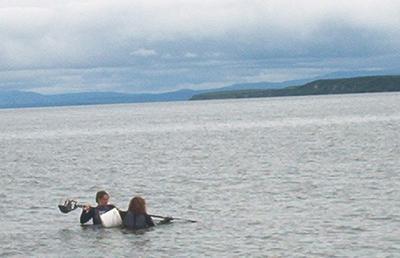5 July, 2003
Clams for Kate
Today in Kotzebue
The weather is
sunny and is has been in the 60’s so we don’t have to dress in
jackets. We are all a little tired after staying up late for the
fourth.
What Science Is Happening?
Kate Meltzer, our grad student, has brought along an experiment of
her own to work on. She is going to feed clams different things that
are available in the ocean in different amounts to see which helps them
grow best. This is an important experiment because one of the things
these clams eat is ice algae. As the Arctic gets warmer, there will be
less ice and less algae. If these bottom-of-the-food-chain feeders can
do as well on other food sources that will be less of a disturbance in
higher trophic levels.
Kate didn’t fair too well today. She went to purchase supplies to
build a floating feeding station but the only store in town was closed
for the holiday weekend. Then Kate and Lisa put on wet suits and we
dragged sampling equipment down to the rocky coast. After wading out
chest high in the Arctic water, however, we were unable to get mud
samples containing clams. We will have to take grabs from the boat in
water farther out.
Dr. William Ambrose arrived today from Maine, very tired and missing
luggage. We managed to have a nice dinner before everyone tumbled off
into bed. Long day tomorrow, we will have 8 hours on the boat and
another 6 processing samples when we return.
Classroom Connections:
Global Warming Fact or Fiction?
A debate
rages as to whether or not planet Earth is getting warmer. Some say
yes and some say no. One of the big problems is that the argument is
very political. Some people blame the warming on the gases that come
out of car exhausts and say there should be laws to make people drive
less. Other people say it is happening naturally, just like the ice
ages. People can be so caught up in blaming that they aren’t good
fact detectives. This is where you come in.
Divide into teams and research the following in your library or
online:
1.) What has the temperature been doing since we started
recording it a little over a hundred years ago? Things to consider: Is
100 years a good length of time to use to study, why or why not? (hint:
The dinosaurs died out “suddenly”. The word ‘suddenly’ in this case
means over 100,000 years)
2.) How could the TEK (traditional
ecological knowledge) that we are studying in Kotzebue give us access
to more than one lifetime’s perspective? Other history can be
researched. There are illustrations of “Ice Fairs” that were held in
London in the middle ages, every year on the Thames, the main water
way, when it froze over. This river hasn’t frozen over in many years
now.
3.)What are “green house gases” and what do they do?
4.)
What makes green house gases, (don’t forget volcanoes, they make more
air pollution than all the cars out together) and how much of an effect
for how much gas produced? Predict what will happen in 10 years and 100
years.
5.) What will the effect be on the environment (animals and
plants) if the temperature warms? In some places in Europe, spring
comes 3 weeks sooner. This is bad news for the polar bears. They need
the ice edge to hunt from because they eat seals. That means less cubs
are born and bears are less nourished.
6.) What about the impact on
humans? Remember, the poles will melt and there is a continent the size
of the United States and Mexico combined covered with 2 miles of ice at
the bottom of the world. When that melts what will happen to the level
of the sea? What will happen to towns, like Kotzebue, by the water?
When you are all finished you can make a class display and
give “the real scoop” on global warming.
Reflections
This was the first
day I was able to walk down the beach. One difference I have noticed
in Kotzebue is that people don’t “fight” nature as much as we do at
home. There aren’t cultivated yards, the flowers are all natural and
death too is a part of nature. As we walked that short stretch, I saw
several seals or possibly baby beluga’s that didn’t survive the
winter. Some were mere skeletons and some were still a food source for
local animals. Death is one of the things we are often sheltered from,
but as unpleasant as it is, it is a part of life, just the same.
Links
Learn
more about our project here
View curriculum for this project, “Ask a Scientist” and
learn about other Arctic Real Time research at Arctic Alive
City of
Kotzebue Webpage
Listen to the local radio station KOTZ live

Lone scientists headed for Arctic Waters

Lisa and Kate trying in vain for a mud grab, but the shore is too rocky.
Contact the TEA in the field at
.
If you cannot connect through your browser, copy the
TEA's e-mail address in the "To:" line of
your favorite e-mail package.
|






